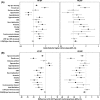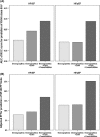Contribution of comorbidities to functional impairment is higher in heart failure with preserved than with reduced ejection fraction
- PMID: 21416189
- PMCID: PMC3167043
- DOI: 10.1007/s00392-011-0305-4
Contribution of comorbidities to functional impairment is higher in heart failure with preserved than with reduced ejection fraction
Abstract
Background: Comorbidities negatively affect prognosis more strongly in heart failure with preserved (HFpEF) than with reduced (HFrEF) ejection fraction. Their comparative impact on physical impairment in HFpEF and HFrEF has not been evaluated so far.
Methods and results: The frequency of 12 comorbidities and their impact on NYHA class and SF-36 physical functioning score (SF-36 PF) were evaluated in 1,294 patients with HFpEF and 2,785 with HFrEF. HFpEF patients had lower NYHA class (2.0 ± 0.6 vs. 2.4 ± 0.6, p < 0.001) and higher SF-36 PF score (54.4 ± 28.3 vs. 54.4 ± 27.7, p < 0.001). All comorbidities were significantly (p < 0.05) more frequent in HFrEF, except hypertension and obesity, which were more frequent in HFpEF (p < 0.001). Adjusting for age and gender, COPD, anemia, hyperuricemia, atrial fibrillation, renal dysfunction, cerebrovascular disease and diabetes had a similar (p for interaction > 0.05) negative effect in both groups. Obesity, coronary artery disease and peripheral arterial occlusive disease exerted a significantly (p < 0.05) more adverse effect in HFpEF, while hypertension and hyperlipidemia were associated with fewer (p < 0.05) symptoms in HFrEF only. The total impact of comorbidities on NYHA (AUC for prediction of NYHA III/IV vs. I/II) and SF-36 PF (r(2)) in multivariate analyses was approximately 1.5-fold higher in HFpEF, and also much stronger than the impact of a 10% decrease in ejection fraction in HFrEF or a 5 mm decrease in left ventricular end-diastolic diameter in HFpEF.
Conclusion: The impact of comorbidities on physical impairment is higher in HFpEF than in HFrEF. This should be considered in the differential diagnosis and in the treatment of patients with HFpEF.
Figures



References
-
- Braunstein JB, Anderson GF, Gerstenblith G, Weller W, Niefeld M, Herbert R, et al. Noncardiac comorbidity increases preventable hospitalizations and mortality among Medicare beneficiaries with chronic heart failure. J Am Coll Cardiol. 2003;42(7):1226–1233. doi: 10.1016/S0735-1097(03)00947-1. - DOI - PubMed
Publication types
MeSH terms
LinkOut - more resources
Full Text Sources
Medical

